![]()
![]()
![]()
Use LEFT and RIGHT arrow keys to navigate between flashcards;
Use UP and DOWN arrow keys to flip the card;
H to show hint;
A reads text to speech;
74 Cards in this Set
- Front
- Back
|
Tatlin
Counter-Relief 1917 |
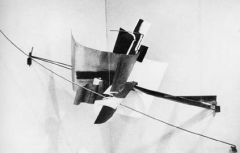
Russian Constructavism:
Tatlin and Materia Culture |
|
|
Tatlin
Model for the Monument to the Third International 1919-1920 |
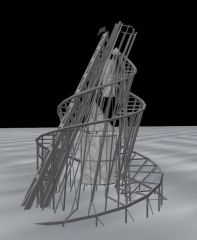
Russian Constructavism:
Tatlin and Materia Culture |
|
|
Gabo
Head of a Woman 1917-1920 |
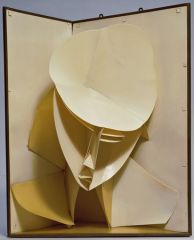
Russian Constructavism:
Tatlin and Materia Culture |
|
|
Gabo
Kinetic Construction: Vibrating Spring 1920 |
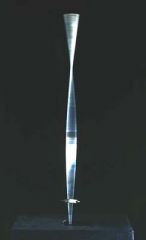
Russian Constructavism:
Tatlin and Materia Culture |
|
|
Pevsner
Construction in the Egg 1948 |

Russian Constructavism:
Tatlin and Materia Culture |
|
|
Rodchenko
Suspended Construction in Space 1920 |
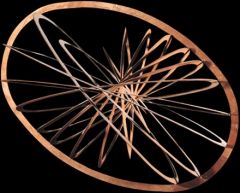
Russian Constructavism:
Tatlin and Materia Culture |
|
|
Rodchenko
Poster Advertisement: "Books" 1925 |
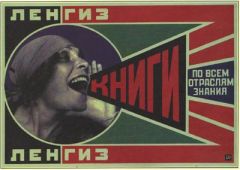
Russian Constructavism:
Tatlin and Materia Culture |
|
|
Rodchenko
At the Telephone 1928 |
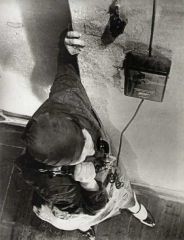
Russian Constructavism:
Tatlin and Materia Culture |
|
|
What is Material Culture?
|
Tatlin
"the culture of materials" From a quote: 1. Research into material as the shaping principle of culture 2. Research into everyday life as a certain form of material culture 3. The synthetic forming of material, and, as a result of such formtion, the construction of standards for new experience •actual characteristics of a material •shape culture, can’t be taken for granted •shape how we evolve •live in a culture with steel/iron vs one without—very different •how we live and react with materials •research based endevor obased on engineering, design, and politics osteel, iron, glass, and what those materials could do •steel and iron have strength •emblematic of power •enable us to make massive structures, or ones that may seem unstable |
|
|
Russian Constructavism
|
•Mentality that utopian spirit doesn’t live forever
•Results in a lot of international travel •Trying to re-enliven constructivist ideals •Bauhaus, based in Germany Gets it's name around 1920 Has to do with exhibitions and publications |
|
|
Realist Manifesto
|
•Naum Gabo and Antoine Pevsner, 1920
•Examine real space, real dimensions •Working in medium of sculpture •New materials, new ways you can illustrate concept of reality, specifically special relationships •Exhibition: oMoscow, 1921, first official exhibition oReal combinations of work, some hanging, some on floor, as well as paintings on wall oPoster designs, furniture, fabrics, clothing oReal mix! 2 components: •1. Idea art needed to be utilitarian (functional, useable in everyday culture) •2. Interest that might be based on Utopian mentality: works were supposed to serve as explorations of particular ideas…art for arts sake •…ultimately became the utilitarians and constructavists •split to two factions •Kinetic rhythm oMovement •Interested in dynamism •Sculptures that literally move |
|
|
Tatlin
|
Utilitarianism
•Motto: “not the old, not the new, but the necessary” •Plate example, bringing art to everyday •Interested in how his designs for everyday person, clothing, new materials for furniture |
|
|
Gontcharova
Green Forest 1912 |
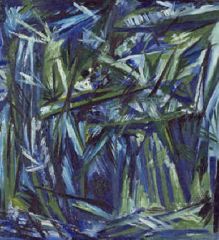
Abstraction in Russia
|
|
|
Rozanova
Unititled (Green Stripe) 1917 |
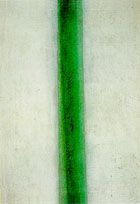
Abstraction in Russia
|
|
|
Malevich
Woman before an Advertisement Column 1914 |
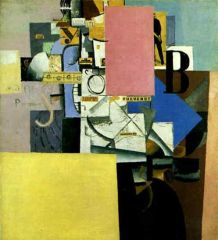
Abstraction in Russia
|
|
|
Malavich
Suprematist Painting (Eight Red Rectangles) 1915 |
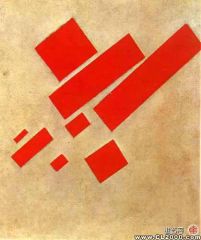
Abstraction in Russia
|
|
|
Popova
The Traveler 1915 |
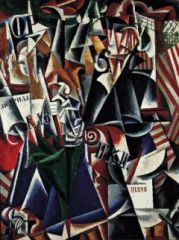
Abstraction in Russia
|
|
|
Rayonism
|
•To move away from the objective world, images and symbols we recognize to create a new vocabulary that is based in aspects of abstract shapes and relationships
•Influence of French Styles *fusion of analytic cubism, futurism, dynamism, Orphism •Angularity, suggestion of modified grid The Rayonists sought an art that floated beyond abstraction, outside of time and space, and to break the barriers between the artist and the public. They derived the name from the use of dynamic rays of contrasting color, representing lines of reflected light — crossing of reflected rays from various objects. |
|
|
Non-representational
|
•Not trying to be like a photo
•Not symbolic in any way •Unnatural colors, unrealistic colors |
|
|
autonomous art
|
•Art that is not linked to a utilitarian function
•Didn’t believe art had to serve a function other than it’s own existence, it’s artness •In a sense written text to her own manifesto |
|
|
Abstraction in Russia intersted in...
|
analytic cubism, futurism, dynamism, Orphism (radiation of multiple shapes, stimulating multiple senses at once)
|
|
|
Architectonics
|
•The blue print, reduced down form
•Starts with The Traveler, crazy one, reduces down to simple one •Examination of a formal language: lines, colors, shape, background •How it functions as an equation •An analytical way of how you can define abstraction •Quote on handout •Not interested in grounding her paintings in reality •“Paintings that are linked in reality suffer in illusions, literariness, linked to sense of emotions, superficial, operates only on plane of recognition” |
|
|
Cubo-Futurism
|
Malavich
•Reducing down figures to be simplistic geometric shapes The Cubo-Futurist works combine the Cubist usage of forms with the Futurist interest in dynamism. |
|
|
nonsense realism
|
suggestion of things based on reality
|
|
|
suprematism
|
•Abstract replaces natural world
•utopian an art movement focused on fundamental geometric forms (squares and circles) which formed in Russia in 1913. *"Under Suprematism, I understand the supremacy of pure feelign in creative art. To the Suprematist, the visual phenomena of the objective world are, in themselves, meaningless; the significant thing is feeling, as such, quite apart from teh environment in which it is called forth," Malevich |
|
|
square paintings
|
•red square
•white square •ridiculously simplified •come back to Malevich’s own definitions: osignificant because of title •pictoral realism of a peasant woman in 2 dimensions oshe’s simple but not a perfect square owhy red? |
|
|
Victory Over The Sun, 1913
|
Malevich also ascribed the birth of Suprematism to the Victory Over the Sun, Kruchenykh's Futurist opera production for which he designed the sets and costumes in 1913. One of the drawings for the backcloth shows a black square divided diagonally into a black and a white triangle. Because of the simplicity of these basic forms they were able to signify a new beginning.
|
|
|
Mondrian
The Red Tree 1909 |
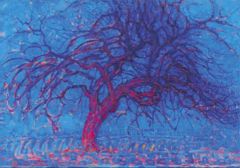
De Stijl in the Netherlands
|
|
|
Mondrian
Flowering Apple Tree 1912 *geometric lines, playing with structure/parts *energy of form, directionality, hints at flower forms |
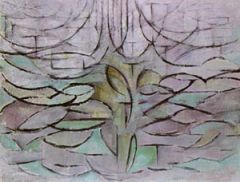
De Stijl in the Netherlands
|
|
|
Mondrian
Composition No. 10: Pier and Ociean 1915 *"plus and minus compositions" *not interested in abstract notion, but rather analyze structure even further *suggestion of depth based upon overlapping *or playing with rhythm of color tones and contrasts to a grid system |
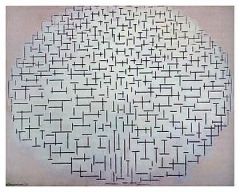
De Stijl in the Netherlands
|
|
|
Mondrian
Composition with Red, Blue, and Yellow 1930 •how you can work not only with negative and positive space, interaction between the grid and expanse of white •harmony and balance that is in everyone’s visual vocabulary •primary colors, basis for visual world •90 degree angle implies visual representation of harmony and balance |
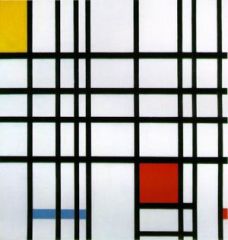
De Stijl in the Netherlands
|
|
|
Mondrian
Broadway Boogie-Woogie 1942-1943 Why the title? new, culture of new york in 1940's, source of inspiration jazz music, momentum of the city |
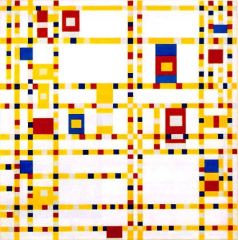
De Stijl in the Netherlands
|
|
|
Page 203
flat primary colors, interlocking De Stijl in the Netherlands |
Theo Van Doesburg
Color Study for a Building 1922 |
|
|
Rietveld
Schroeder House Utrecht 1925 •Commissioned for a woman to live in •Visual 3-D rendition of component painting •Sliding screens on tracks •Change space according to who’s living in environment •Windows are the walls/art •The whole house is art rather than the need to put it in •Natural light, walls have a transparency •If you have walls that can disappear or reappear, walls aren’t solid with windows, sense of openness and space |
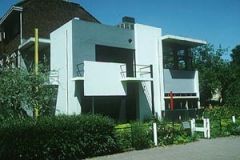
De Stijl in the Netherlands
|
|
|
De Stijl (The Style)
|
Founded by..Malavich, Mondrain, 1917!
Proponents of De Stijl sought to express a new utopian ideal of spiritual harmony and order. They advocated pure abstraction and universality by a reduction to the essentials of form and colour — they simplified visual compositions to the vertical and horizontal directions, and used only primary colors along with black and white. •Title for movement and widely read publication •Poetry, essay, visual images •Urban planners included •Application for life, for how cities are structured, furniture, architecture De Stijl proposed ultimate simplicity and abstraction, both in architecture and painting, by using only straight (horizontal and vertical) lines and rectangular forms. The colour palette was reduced to the primary colours red, yellow and blue. Black, white and grey were used as well. The works avoided symmetry and attained aesthetic balance by the use of opposition. |
|
|
Theosophy
|
theosophy as an inspiration. These artists were interested in art seeking a higher purpose other than the mere accurate representation of nature.
oSpiritualize your work oSpeaks to a higher spiritual consciousness |
|
|
Neo-Plastic art and "pure plastic art"
|
Neo-Plastic art and “pure plastic art”
•Lozenge works •Tilting canvas •What is he trying to achieve at this point? •Quote on page: o“The balanced relation is the purest representation of universality, of the harmony and unity which are the inherence characteristics of the mind”—Mondrian from natural Reality and Abstract Reality, 1919 |
|
|
Mondrian
|
•Concept of utilitarian world
•Expects painting arts, fine arts, will eventually die •Even though most of his work is painting •Won’t need a space for painting, sculpture •Culturally at least |
|
|
Hugo Ball
Photo of Ball reciting the poem, Karawane, at the Cabaret Voltaire, Zurich, 1916 |
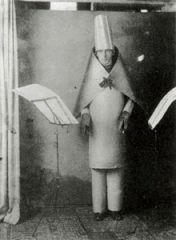
Dada: Anti-Art and Cultural Critique in Zurich
|
|
|
Marcel Janco
Mask 1919 |

Dada: Anti-Art and Cultural Critique in Zurich
|
|
|
Sophie Taeuber-Artp
Dada Head: Portrait of Jean Arp 1918 |

Dada: Anti-Art and Cultural Critique in Zurich
|
|
|
Jean Arp
Arrangement According to the Laws of Chance 1916-1917 |
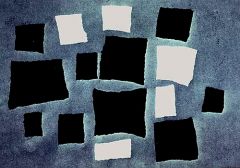
Dada: Anti-Art and Cultural Critique in Zurich
|
|
|
Jean Arp
The Forest 1916 |
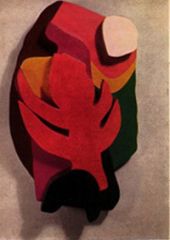
Dada: Anti-Art and Cultural Critique in Zurich
|
|
|
Dada
|
"Dada is a state of mind. Dada applies itself to everything, and yet it is nothing, it is the point where the yes and the no and the opposites meet. " Tzara
According to its proponents, Dada was not art — it was "anti-art". Dada sought to fight art with art. For everything that art stood for, Dada was to represent the opposite. Where art was concerned with aesthetics, Dada ignored aesthetics. If art were to have at least an implicit or latent message, Dada strove to have no meaning — interpretation of Dada is dependent entirely on the viewer. If art is to appeal to sensibilities, Dada is to offend. It is perhaps then ironic that Dada became an influential movement in modern art. Dada became a commentary on order and the carnage they believed it wreaked. Through this rejection of traditional culture and aesthetics they hoped to destroy traditional culture and aesthetics. •Reevaluating definition of how art functions in contemporary society, what is high art? |
|
|
Dada in French
|
child's word for hobby-horse
|
|
|
Zurich members
|
Ball
Hennings Tzara Janco Arp Sophie Taeuber-Arp Huelsenbeck Richter |
|
|
manifesto
|
Art manifestos are mostly extreme in their rhetoric and intended for shock value to achieve a revolutionary effect. They often address wider issues, such as the political system. Typical themes are the need for revolution, freedom (of expression) and the implied or overtly stated superiority of the writers over the status quo. The manifesto gives a means of expressing, publicising and recording ideas for the artist or art group— even if only one or two people write the words, it is mostly still attributed to the group name.
|
|
|
Tristan Tzara
|
•Devoted to concept of autonomism, no rules to writing
•Working in tandem with art •“continuous contradiction” “immediate spontaneity” •break the mold, create a new sense of freedom |
|
|
First International Dada Fair
|
1919, big open space, display tactics different than conventional gallery
|
|
|
Cabaret Voltaire (1916)
|
a nightclub in Zürich, Switzerland. It was founded by Hugo Ball, with his companion Emmy Hennings on February 5, 1916 as a cabaret for artistic and political purposes. Other founder members were Marcel Janco, Richard Huelsenbeck, Tristan Tzara and Jean Arp. Events at the cabaret proved pivotal in the founding of the anarchic art movement known as Dada.
|
|
|
Collage (and collage according to the laws of chance)
|
Arp made "chance collages" such as this one: by tearing paper into pieces, dropping them onto a larger sheet, and pasting each scrap wherever it happened to fall. The relatively ordered appearance of Arp's collages suggests, however, that the artist did not fully relinquish artistic control.
|
|
|
bruitisme
|
sub-genre of experimental music constructed from noise as opposed to recognisable sound or pitches
|
|
|
Duchamp
Bicycle Wheel 1913 |
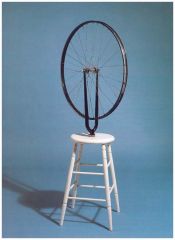
The Spread of Dada: New York, Hannover, Paris
|
|
|
Duchamp
Bottle Rack 1914 |

The Spread of Dada: New York, Hannover, Paris
|
|
|
Duchamp
The Fountain 1917 |
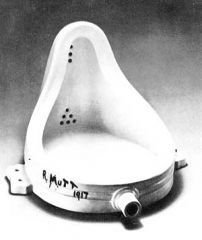
The Spread of Dada: New York, Hannover, Paris
|
|
|
Duchamp
LHOOQ 1919 |
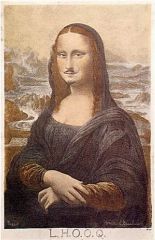
The Spread of Dada: New York, Hannover, Paris
|
|
|
Duchamp
The Bride Stripped Bare by Her Bachelors Even (The Large Glass) 1915-1923 |
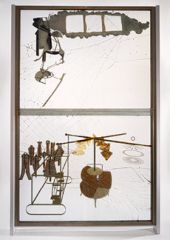
The Spread of Dada: New York, Hannover, Paris
|
|
|
Picabia
Ici, c'est ici Stieglitz 1915 |
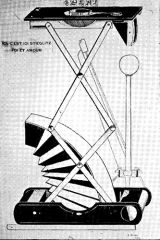
The Spread of Dada: New York, Hannover, Paris
|
|
|
Picabia
Amorous Parade 1917 |
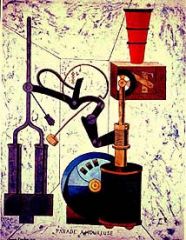
The Spread of Dada: New York, Hannover, Paris
|
|
|
Schwitters
Merz Construction 1921 |
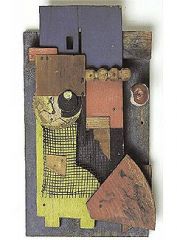
The Spread of Dada: New York, Hannover, Paris
|
|
|
Schwitters
Merz 94 Grunflec 1920 (similar) |
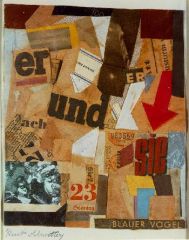
(sorta)
The Spread of Dada: New York, Hannover, Paris |
|
|
Schwitters
Merzbau Hannover 1924-1933 |
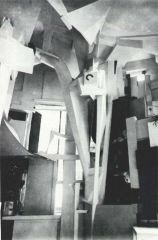
The Spread of Dada: New York, Hannover, Paris
|
|
|
Man Ray
Gift 1921 |
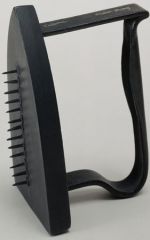
The Spread of Dada: New York, Hannover, Paris
|
|
|
Man Ray
Rayograph, from Les champs delicieux 1922 similar |
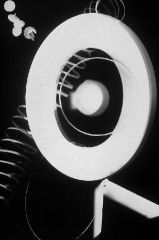
The Spread of Dada: New York, Hannover, Paris
(sorta) |
|
|
ready-made
|
ordinary manufactured objects that he selected then sometimes modified, and deemed art. By choosing the object, giving it a title and signing it, the object became a work of art.
|
|
|
Merzbild
MerzBau |
Merz Pictures
Merz Building |
|
|
Merz
|
he began making assemblages from scraps of refuse, including one he called the Merz picture. Subsequently he referred to all his work as Merz.
"had no meaning when i formed it. Now it has the meaning which I gave it. the meanign of the concept 'Merz' changes with the changes in the insight of those who continue to work with it. Merz stands for freedom from all fetters, for the sake of artistc creation. freedom is not lack of restraint, but the product of strict artistic discipline" --schwitters |
|
|
291 Gallery
|
The Little Galleries of the Photo-Secession (later known as 291) was a tiny fine art photography gallery in New York City created and run by Alfred Stieglitz and Edward Steichen from November 1905 to 1917.
The gallery helped bring art photography, initially that in the Pictorialist style, to the same level of appreciation in America as painting and sculpture. This was helped by Stieglitz's publication from the 291 offices of the magazine Camera Work. It was the first dedicated art photography gallery in the world, and was funded by the sale of prints, subscriptions to the journal Camera Work, and Alfred's financial allowance. In its final years the 291 gallery featured American modern artists - such as John Marin, Arthur Beecher Carles, Bessie Buehrmann, Arthur Dove, Andrew Dasburg and Oscar Bluemner. It also famously showed the early watercolors and charcoals of the young Georgia O'Keefe, who would later marry Stieglitz. |
|
|
Berlin Dada
|
more of a philosophy
The groups in Germany were not as strongly anti-art as other groups. Their activity and art was more political and social, with corrosive manifestos and propaganda, biting satire, large public demonstrations and overt political activities. It has been suggested that this is at least partially due to Berlin's proximity to the front, and that for an opposite effect, New York's geographic distance from the war spawned its more theoretically-driven, less political nature. Hannah Höch and George Grosz used Dada to express post-World War I communist sympathies. Grosz, together with John Heartfield, developed the technique of photomontage during this period. The artists published a series of short-lived political journals, and held the International Dada Fair in 1920. |
|
|
New York Dada
|
Like Zürich, New York was a refuge for writers and artists from World War I. Soon after arriving from France, Marcel Duchamp and Francis Picabia met American artist Man Ray after arriving only days apart in June of 1915. By 1916 the three of them became the center of radical anti-art activities in the United States. American Beatrice Wood, who had been studying in France, soon joined them. Much of their activity centered in Alfred Stieglitz's gallery, 291, and the studio of Walter and Louise Arensberg.
The New Yorkers did not label themselves Dada, nor did they issue manifestos or organize riotous events. However, they issued challenges to art and culture through publications such as The Blind Man, Rongwrong, and New York Dada in which they criticized the traditionalist basis for museum art. New York Dada lacked the disillusionment of European Dada and was instead driven by a sense of irony and humor. During this time Duchamp began exhibiting readymades (found objects) such as a bottle rack, and got involved with the Society of Independent Artists. |
|
|
rayograph
|
A photogram is a photographic image made (without a camera) by placing objects directly onto the surface of a photo-sensitive material such as photographic paper and then exposing it to light.
|
|
|
Paris Dada
|
The French avant-garde kept abreast of Dada activities in Zürich with regular communications from Tristan Tzara (whose pseudonym means "sad in country," a name chosen to protest the treatment of Jews in his native Romania), who exchanged letters, poems, and magazines with Guillaume Apollinaire, André Breton, Max Jacob, and other French writers, critics and artists.
Dada in Paris surged in 1920 when many of the originators converged there. Inspired by Tzara, Paris Dada soon issued manifestos, organized demonstrations, staged performances and produced a number of journals (the final two editions of Dada, Le Cannibale, and Littérature featured Dada in several editions.) The first introduction of Dada artwork to the Parisian public was at the Salon des Indépendants in 1921. Jean Crotti exhibited works associated with Dada including a work entitled, Explicatif bearing the word Tabu. |
|
|
Andre Breton
|
André Breton was a French writer, poet, and surrealist theorist, and is best known as the main founder of surrealism. His writings include the Surrealist Manifesto of 1924, in which he defined surrealism as pure psychic automatism.
|
|
|
Rose Selavy ("eros, c'est la vie")
|
Duchamp's female alter-ego
eros, it is life |

